Sea

A sea is a large body of salty water. There are particular seas and the sea. The sea commonly refers to the ocean, the wider body of seawater.
The
The ocean moderates Earth's
A wide variety of organisms, including bacteria, protists, algae, plants, fungi, and animals, lives in the seas, which offers a wide range of marine habitats and ecosystems, ranging vertically from the sunlit surface and shoreline to the great depths and pressures of the cold, dark abyssal zone, and in latitude from the cold waters under polar ice caps to the warm waters of coral reefs in tropical regions. Many of the major groups of organisms evolved in the sea and life may have started there.
The seas have been an integral element for humans throughout history and culture. Humans harnessing and studying the seas have been recorded since ancient times and evidenced well into prehistory, while its modern scientific study is called oceanography and maritime space is governed by the law of the sea, with admiralty law regulating human interactions at sea. The seas provide substantial supplies of food for humans, mainly
.Definition

The sea is the interconnected system of all the Earth's oceanic waters, including the
Legal definition
The
Physical science

The
Seawater
Salinity
A characteristic of seawater is that it is salty. Salinity is usually measured in parts per thousand (
While the constituents of table salt (
| Solute | Concentration (‰) | % of total salts |
|---|---|---|
| Chloride | 19.3 | 55 |
| Sodium | 10.8 | 30.6 |
Sulphate |
2.7 | 7.7 |
| Magnesium | 1.3 | 3.7 |
| Calcium | 0.41 | 1.2 |
| Potassium | 0.40 | 1.1 |
| Bicarbonate | 0.10 | 0.4 |
| Bromide | 0.07 | 0.2 |
| Carbonate | 0.01 | 0.05 |
| Strontium | 0.01 | 0.04 |
| Borate | 0.01 | 0.01 |
| Fluoride | 0.001 | <0.01 |
| All other solutes | <0.001 | <0.01 |
Although the amount of salt in the ocean remains relatively constant within the scale of millions of years, various factors affect the salinity of a body of water.
Temperature
Sea temperature depends on the amount of solar radiation falling on its surface. In the tropics, with the sun nearly overhead, the temperature of the surface layers can rise to over 30 °C (86 °F) while near the poles the temperature in equilibrium with the sea ice is about −2 °C (28 °F). There is a continuous circulation of water in the oceans. Warm surface currents cool as they move away from the tropics, and the water becomes denser and sinks. The cold water moves back towards the equator as a deep sea current, driven by changes in the temperature and density of the water, before eventually welling up again towards the surface. Deep seawater has a temperature between −2 °C (28 °F) and 5 °C (41 °F) in all parts of the globe.[30]
Seawater with a typical salinity of 35 ‰ has a freezing point of about −1.8 °C (28.8 °F).[
pH value
Seawater is slightly alkaline and had an average pH of about 8.2 over the past 300 million years.[32] More recently, climate change has resulted in an increase of the carbon dioxide content of the atmosphere; about 30–40% of the added CO2 is absorbed by the oceans, forming carbonic acid and lowering the pH (now below 8.1[32]) through a process called ocean acidification.[33][34][35] The extent of further ocean chemistry changes, including ocean pH, will depend on climate change mitigation efforts taken by nations and their governments.[36]
Oxygen concentration
The amount of oxygen found in seawater depends primarily on the plants growing in it. These are mainly algae, including
Climate change is likely to reduce levels of oxygen in surface waters since the solubility of oxygen in water falls at higher temperatures.[38] Ocean deoxygenation is projected to increase hypoxia by 10%, and triple suboxic waters (oxygen concentrations 98% less than the mean surface concentrations), for each 1 °C of upper-ocean warming.[39]
Light
The amount of light that penetrates the sea depends on the angle of the sun, the weather conditions and the turbidity of the water. Much light gets reflected at the surface, and red light gets absorbed in the top few metres. Yellow and green light reach greater depths, and blue and violet light may penetrate as deep as 1,000 metres (3,300 ft). There is insufficient light for photosynthesis and plant growth beyond a depth of about 200 metres (660 ft).[40]
Sea level
Over most of geologic time, the sea level has been higher than it is today.
For at least the last 100 years, sea level has been rising at an average rate of about 1.8 millimetres (0.071 in) per year.[43] Most of this rise can be attributed to an increase in the temperature of the sea due to climate change, and the resulting slight thermal expansion of the upper 500 metres (1,600 ft) of water. Additional contributions, as much as one quarter of the total, come from water sources on land, such as melting snow and glaciers and extraction of groundwater for irrigation and other agricultural and human needs.[44]
Waves

Wind blowing over the surface of a body of water forms
The top of a wave is known as the crest, the lowest point between waves is the trough and the distance between the crests is the wavelength. The wave is pushed across the surface of the sea by the wind, but this represents a transfer of energy and not a horizontal movement of water. As waves approach land and
Tsunami

A tsunami is an unusual form of wave caused by an infrequent powerful event such as an underwater earthquake or landslide, a meteorite impact, a volcanic eruption or a collapse of land into the sea. These events can temporarily lift or lower the surface of the sea in the affected area, usually by a few feet. The potential energy of the displaced seawater is turned into kinetic energy, creating a shallow wave, a tsunami, radiating outwards at a velocity proportional to the square root of the depth of the water and which therefore travels much faster in the open ocean than on a continental shelf.[52] In the deep open sea, tsunamis have wavelengths of around 80 to 300 miles (130 to 480 km), travel at speeds of over 600 miles per hour (970 km/h)[53] and usually have a height of less than three feet, so they often pass unnoticed at this stage.[54] In contrast, ocean surface waves caused by winds have wavelengths of a few hundred feet, travel at up to 65 miles per hour (105 km/h) and are up to 45 feet (14 metres) high.[54]
As a tsunami moves into shallower water its speed decreases, its wavelength shortens and its amplitude increases enormously,[54] behaving in the same way as a wind-generated wave in shallow water but on a vastly greater scale. Either the trough or the crest of a tsunami can arrive at the coast first.[52] In the former case, the sea draws back and leaves subtidal areas close to the shore exposed which provides a useful warning for people on land.[55] When the crest arrives, it does not usually break but rushes inland, flooding all in its path. Much of the destruction may be caused by the flood water draining back into the sea after the tsunami has struck, dragging debris and people with it. Often several tsunami are caused by a single geological event and arrive at intervals of between eight minutes and two hours. The first wave to arrive on shore may not be the biggest or most destructive.[52]
Currents
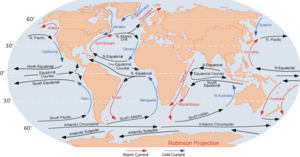
Wind blowing over the surface of the sea causes
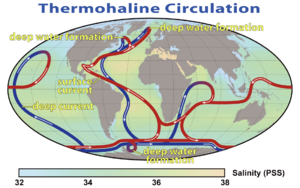
Surface currents only affect the top few hundred metres of the sea, but there are also large-scale flows in the ocean depths caused by the movement of deep water masses. A main deep ocean current flows through all the world's oceans and is known as the thermohaline circulation or global conveyor belt. This movement is slow and is driven by differences in density of the water caused by variations in salinity and temperature.[60] At high latitudes the water is chilled by the low atmospheric temperature and becomes saltier as sea ice crystallizes out. Both these factors make it denser, and the water sinks. From the deep sea near Greenland, such water flows southwards between the continental landmasses on either side of the Atlantic. When it reaches the Antarctic, it is joined by further masses of cold, sinking water and flows eastwards. It then splits into two streams that move northwards into the Indian and Pacific Oceans. Here it is gradually warmed, becomes less dense, rises towards the surface and loops back on itself. It takes a thousand years for this circulation pattern to be completed.[57]
Besides gyres, there are temporary surface currents that occur under specific conditions. When waves meet a shore at an angle, a longshore current is created as water is pushed along parallel to the coastline. The water swirls up onto the beach at right angles to the approaching waves but drains away straight down the slope under the effect of gravity. The larger the breaking waves, the longer the beach and the more oblique the wave approach, the stronger is the longshore current.[61] These currents can shift great volumes of sand or pebbles, create spits and make beaches disappear and water channels silt up.[57] A rip current can occur when water piles up near the shore from advancing waves and is funnelled out to sea through a channel in the seabed. It may occur at a gap in a sandbar or near a man-made structure such as a groyne. These strong currents can have a velocity of 3 ft (0.9 m) per second, can form at different places at different stages of the tide and can carry away unwary bathers.[62] Temporary upwelling currents occur when the wind pushes water away from the land and deeper water rises to replace it. This cold water is often rich in nutrients and creates blooms of phytoplankton and a great increase in the productivity of the sea.[57]
Tides
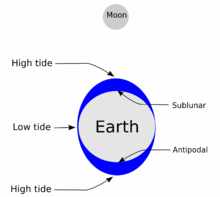
Tides are the regular rise and fall in water level experienced by seas and oceans in response to the
Most places experience two high tides each day, occurring at intervals of about 12 hours and 25 minutes. This is half the 24 hours and 50 minute period that it takes for the Earth to make a complete revolution and return the Moon to its previous position relative to an observer. The Moon's mass is some 27 million times smaller than the Sun, but it is 400 times closer to the Earth.[65] Tidal force or tide-raising force decreases rapidly with distance, so the moon has more than twice as great an effect on tides as the Sun.[65] A bulge is formed in the ocean at the place where the Earth is closest to the Moon because it is also where the effect of the Moon's gravity is stronger. On the opposite side of the Earth, the lunar force is at its weakest and this causes another bulge to form. As the Moon rotates around the Earth, so do these ocean bulges move around the Earth. The gravitational attraction of the Sun is also working on the seas, but its effect on tides is less powerful than that of the Moon, and when the Sun, Moon and Earth are all aligned (full moon and new moon), the combined effect results in the high "spring tides". In contrast, when the Sun is at 90° from the Moon as viewed from Earth, the combined gravitational effect on tides is less causing the lower "neap tides".[63]
A storm surge can occur when high winds pile water up against the coast in a shallow area and this, coupled with a low-pressure system, can raise the surface of the sea at high tide dramatically.
Ocean basins

The Earth is composed of a magnetic central
The Earth's deepest trench is the Mariana Trench which extends for about 2,500 kilometres (1,600 mi) across the seabed. It is near the Mariana Islands, a volcanic archipelago in the West Pacific. Its deepest point is 10.994 kilometres (nearly 7 miles) below the surface of the sea.[69]
Coasts
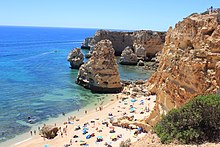

The zone where land meets sea is known as the
Material worn from the margins of the land eventually ends up in the sea. Here it is subject to attrition as currents flowing parallel to the coast scour out channels and transport sand and pebbles away from their place of origin. Sediment carried to the sea by rivers settles on the seabed causing deltas to form in estuaries. All these materials move back and forth under the influence of waves, tides and currents.[70] Dredging removes material and deepens channels but may have unexpected effects elsewhere on the coastline. Governments make efforts to prevent flooding of the land by the building of breakwaters, seawalls, dykes and levees and other sea defences. For instance, the Thames Barrier is designed to protect London from a storm surge,[72] while the failure of the dykes and levees around New Orleans during Hurricane Katrina created a humanitarian crisis in the United States.
Water cycle
The sea plays a part in the
In central Asia and other large land masses, there are
Carbon cycle
Oceans contain the greatest quantity of actively cycled carbon in the world and are second only to the lithosphere in the amount of carbon they store.[76] The oceans' surface layer holds large amounts of dissolved organic carbon that is exchanged rapidly with the atmosphere. The deep layer's concentration of dissolved inorganic carbon is about 15 percent higher than that of the surface layer[77] and it remains there for much longer periods of time.[78] Thermohaline circulation exchanges carbon between these two layers.[76]
Carbon enters the ocean as atmospheric carbon dioxide dissolves in the surface layers and is converted into carbonic acid, carbonate, and bicarbonate:[79]
- CO2 (gas) ⇌ CO2 (aq)
- CO2 (aq) + H2O ⇌ H2CO3
- H2CO3 ⇌ HCO3− + H+
- HCO3− ⇌ CO32− + H+
It can also enter through rivers as dissolved organic carbon and is converted by photosynthetic organisms into organic carbon. This can either be exchanged throughout the food chain or precipitated into the deeper, more carbon-rich layers as dead soft tissue or in shells and bones as calcium carbonate. It circulates in this layer for long periods of time before either being deposited as sediment or being returned to surface waters through thermohaline circulation.[78]
Life in the sea
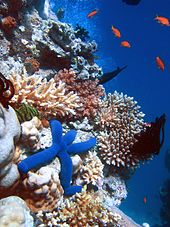
| Marine habitats |
|---|
| Coastal habitats |
| Ocean surface |
|
| Open ocean |
| Sea floor |
The oceans are home to a diverse collection of life forms that use it as a habitat. Since sunlight illuminates only the upper layers, the major part of the ocean exists in permanent darkness. As the different depth and temperature zones each provide habitat for a unique set of species, the marine environment as a whole encompasses an immense diversity of life.
Life may have originated in the sea and all the
Marine habitats
Marine habitats can be divided horizontally into coastal and open ocean habitats. Coastal habitats extend from the shoreline to the edge of the continental shelf. Most marine life is found in coastal habitats, even though the shelf area occupies only 7 percent of the total ocean area. Open ocean habitats are found in the deep ocean beyond the edge of the continental shelf. Alternatively, marine habitats can be divided vertically into pelagic (open water), demersal (just above the seabed) and benthic (sea bottom) habitats. A third division is by latitude: from polar seas with ice shelves, sea ice and icebergs, to temperate and tropical waters.[3]: 150–151
Coral reefs, the so-called "rainforests of the sea", occupy less than 0.1 percent of the world's ocean surface, yet their ecosystems include 25 percent of all marine species.
Algae and plants
Marine
Light is only able to penetrate the top 200 metres (660 ft) so this is the only part of the sea where plants can grow.[40] The surface layers are often deficient in biologically active nitrogen compounds. The marine nitrogen cycle consists of complex microbial transformations which include the fixation of nitrogen, its assimilation, nitrification, anammox and denitrification.[92] Some of these processes take place in deep water so that where there is an upwelling of cold waters, and also near estuaries where land-sourced nutrients are present, plant growth is higher. This means that the most productive areas, rich in plankton and therefore also in fish, are mainly coastal.[3]: 160–163
Animals and other marine life
There is a broader spectrum of higher animal
The pelagic zone contains
The demersal zone supports many animals that feed on benthic organisms or seek protection from predators and the seabed provides a range of habitats on or under the surface of the
Humans and the sea
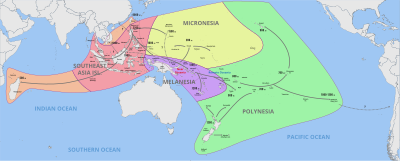
Humans have
The

As for the history of
With regards to maps that are vital for navigation, in the second century,
History of oceanography and deep sea exploration
Scientific oceanography began with the voyages of Captain James Cook from 1768 to 1779, describing the Pacific with unprecedented precision from 71 degrees South to 71 degrees North.
On her 68,890-nautical-mile (127,580 km) journey round the globe, HMS Challenger discovered about 4,700 new marine species, and made 492 deep sea soundings, 133 bottom dredges, 151 open water trawls and 263 serial water temperature observations.
At great depths, no light penetrates through the water layers from above and the pressure is extreme. For deep sea exploration it is necessary to use specialist vehicles, either remotely operated underwater vehicles with lights and cameras or crewed submersibles. The battery-operated Mir submersibles have a three-person crew and can descend to 20,000 feet (6,100 m). They have viewing ports, 5,000-watt lights, video equipment and manipulator arms for collecting samples, placing probes or pushing the vehicle across the sea bed when the thrusters would stir up excessive sediment.[120]
Ongoing oceanographic research includes marine lifeforms, conservation, the marine environment, the chemistry of the ocean, the studying and modelling of climate dynamics, the air-sea boundary, weather patterns, ocean resources, renewable energy, waves and currents, and the design and development of new tools and technologies for investigating the deep.[122] Whereas in the 1960s and 1970s, research could focus on taxonomy and basic biology, in the 2010s, attention has shifted to larger topics such as climate change.[123] Researchers make use of satellite-based remote sensing for surface waters, with research ships, moored observatories and autonomous underwater vehicles to study and monitor all parts of the sea.[124]
Law
"Freedom of the seas" is a principle in international law dating from the seventeenth century. It stresses freedom to navigate the oceans and disapproves of war fought in international waters.[125] Today, this concept is enshrined in the United Nations Convention on the Law of the Sea (UNCLOS), the third version of which came into force in 1994. Article 87(1) states: "The high seas are open to all states, whether coastal or land-locked." Article 87(1) (a) to (f) gives a non-exhaustive list of freedoms including navigation, overflight, the laying of submarine cables, building artificial islands, fishing and scientific research.[125] The safety of shipping is regulated by the International Maritime Organization. Its objectives include developing and maintaining a regulatory framework for shipping, maritime safety, environmental concerns, legal matters, technical co-operation and maritime security.[126]
UNCLOS defines various areas of water. "Internal waters" are on the landward side of a
War
Control of the sea is important to the security of a maritime nation, and the naval
With steam and the industrial production of steel plate came greatly increased firepower in the shape of the
Submarines became important in naval warfare in World War I, when German submarines, known as
Travel
Sailing ships or packets carried mail overseas, one of the earliest being the Dutch service to Batavia in the 1670s.[141] These added passenger accommodation, but in cramped conditions. Later, scheduled services were offered but the time journeys took depended much on the weather. When steamships replaced sailing vessels, ocean-going liners took over the task of carrying people. By the beginning of the twentieth century, crossing the Atlantic took about five days and shipping companies competed to own the largest and fastest vessels. The Blue Riband was an unofficial accolade given to the fastest liner crossing the Atlantic in regular service. The Mauretania held the title with 26.06 knots (48.26 km/h) for twenty years from 1909.[142] The Hales Trophy, another award for the fastest commercial crossing of the Atlantic, was won by the United States in 1952 for a crossing that took three days, ten hours and forty minutes.[143]
The great liners were comfortable but expensive in fuel and staff. The age of the trans-Atlantic liners waned as cheap intercontinental flights became available. In 1958, a regular scheduled air service between New York and Paris taking seven hours doomed the Atlantic ferry service to oblivion. One by one the vessels were laid up, some were scrapped, others became cruise ships for the leisure industry and still others floating hotels.[144]
Trade

Maritime trade has existed for millennia. The Ptolemaic dynasty had developed trade with India using the Red Sea ports, and in the first millennium BC, the Arabs, Phoenicians, Israelites and Indians traded in luxury goods such as spices, gold, and precious stones.[145] The Phoenicians were noted sea traders and under the Greeks and Romans, commerce continued to thrive. With the collapse of the Roman Empire, European trade dwindled but it continued to flourish among the kingdoms of Africa, the Middle East, India, China and southeastern Asia.[146] From the 16th to the 19th centuries, over a period of 400 years, about 12–13 million Africans were shipped across the Atlantic to be sold as slaves in the Americas as part of the Atlantic slave trade.[147][148]: 194
Large quantities of goods are transported by sea, especially across the Atlantic and around the Pacific Rim. A major trade route passes through the
Food

Fish and other fishery products are among the most widely consumed sources of protein and other essential nutrients.[156] In 2009, 16.6% of the world's intake of animal protein and 6.5% of all protein consumed came from fish.[156] In order to fulfill this need, coastal countries have exploited marine resources in their exclusive economic zone, although fishing vessels are increasingly venturing further afield to exploit stocks in international waters.[157] In 2011, the total world production of fish, including aquaculture, was estimated to be 154 million tonnes, of which most was for human consumption.[156] The harvesting of wild fish accounted for 90.4 million tonnes, while annually increasing aquaculture contributes the rest.[156] The north west Pacific is by far the most productive area with 20.9 million tonnes (27 percent of the global marine catch) in 2010.[156] In addition, the number of fishing vessels in 2010 reached 4.36 million, whereas the number of people employed in the primary sector of fish production in the same year amounted to 54.8 million.[156]
Modern fishing vessels include

Aquaculture
About 79 million tonnes (78M long tons; 87M short tons) of food and non-food products were produced by aquaculture in 2010, an all-time high. About six hundred species of plants and animals were cultured, some for use in seeding wild populations. The animals raised included
Leisure
Use of the sea for leisure developed in the nineteenth century, and became a significant industry in the twentieth century.
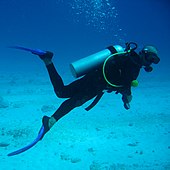
Beneath the surface, freediving is necessarily restricted to shallow descents. Pearl divers can dive to 40 feet (12 m) with baskets to collect oysters.[177] Human eyes are not adapted for use underwater but vision can be improved by wearing a diving mask. Other useful equipment includes fins and snorkels, and scuba equipment allows underwater breathing and hence a longer time can be spent beneath the surface.[178] The depths that can be reached by divers and the length of time they can stay underwater is limited by the increase of pressure they experience as they descend and the need to prevent decompression sickness as they return to the surface. Recreational divers restrict themselves to depths of 100 feet (30 m) beyond which the danger of nitrogen narcosis increases. Deeper dives can be made with specialised equipment and training.[178]
Industry
Power generation
The sea offers a very large supply of
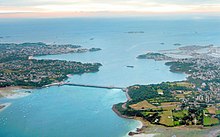
Tidal power uses generators to produce electricity from tidal flows, sometimes by using a dam to store and then release seawater. The Rance barrage, 1 kilometre (0.62 mi) long, near
The large and highly variable energy of waves gives them enormous destructive capability, making affordable and reliable wave machines problematic to develop. A small 2 MW commercial wave power plant, "Osprey", was built in Northern Scotland in 1995 about 300 metres (980 feet) offshore. It was soon damaged by waves, then destroyed by a storm.[3]: 112
Offshore wind power is captured by wind turbines placed out at sea; it has the advantage that wind speeds are higher than on land, though wind farms are more costly to construct offshore.[182] The first offshore wind farm was installed in Denmark in 1991,[183] and the installed capacity of worldwide offshore wind farms reached 34 GW in 2020, mainly situated in Europe.[184]
Extractive industries
The seabed contains large reserves of minerals which can be exploited by dredging. This has advantages over land-based mining in that equipment can be built at specialised shipyards and infrastructure costs are lower. Disadvantages include problems caused by waves and tides, the tendency for excavations to silt up and the washing away of spoil heaps. There is a risk of coastal erosion and environmental damage.[185]
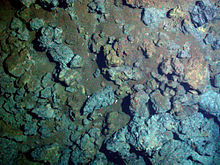
Seafloor massive sulphide deposits are potential sources of silver, gold, copper, lead and zinc and trace metals since their discovery in the 1960s. They form when geothermally heated water is emitted from deep sea hydrothermal vents known as "black smokers". The ores are of high quality but prohibitively costly to extract.[186]
There are large deposits of
Large quantities of

The sea holds large quantities of valuable dissolved minerals.[193] The most important, Salt for table and industrial use has been harvested by solar evaporation from shallow ponds since prehistoric times. Bromine, accumulated after being leached from the land, is economically recovered from the Dead Sea, where it occurs at 55,000 parts per million (ppm).[194]
Fresh water production
Desalination is the technique of removing salts from seawater to leave fresh water suitable for drinking or irrigation. The two main processing methods, vacuum distillation and reverse osmosis, use large quantities of energy. Desalination is normally only undertaken where fresh water from other sources is in short supply or energy is plentiful, as in the excess heat generated by power stations. The brine produced as a by-product contains some toxic materials and is returned to the sea.[195]
Indigenous sea peoples
Several
The indigenous peoples of the Arctic such as the Chukchi, Inuit, Inuvialuit and Yup'iit hunt marine mammals including seals and whales,[199] and the Torres Strait Islanders of Australia include the Great Barrier Reef among their possessions. They live a traditional life on the islands involving hunting, fishing, gardening and trading with neighbouring peoples in Papua and mainland Aboriginal Australians.[200]
In culture
The sea appears in human culture in contradictory ways, as both powerful but serene and as beautiful but dangerous.[3]: 10 It has its place in literature, art, poetry, film, theatre, classical music, mythology and dream interpretation.[201] The Ancients personified it, believing it to be under the control of a being who needed to be appeased, and symbolically, it has been perceived as a hostile environment populated by fantastic creatures; the Leviathan of the Bible,[202] Scylla in Greek mythology,[203] Isonade in Japanese mythology,[204] and the kraken of late Norse mythology.[205]

The sea and ships have been
Music too has been inspired by the ocean, sometimes by composers who lived or worked near the shore and saw its many different aspects. Sea shanties, songs that were chanted by mariners to help them perform arduous tasks, have been woven into compositions and impressions in music have been created of calm waters, crashing waves and storms at sea.[208]: 4–8

As a symbol, the sea has for centuries played a role in literature, poetry and dreams. Sometimes it is there just as a gentle background but often it introduces such themes as storm, shipwreck, battle, hardship, disaster, the dashing of hopes and death.[208]: 45 In his epic poem the Odyssey, written in the eighth century BC,[209] Homer describes the ten-year voyage of the Greek hero Odysseus who struggles to return home across the sea's many hazards after the war described in the Iliad.[210] The sea is a recurring theme in the Haiku poems of the Japanese Edo period poet Matsuo Bashō (松尾 芭蕉) (1644–1694).[211] In the works of psychiatrist Carl Jung, the sea symbolizes the personal and the collective unconscious in dream interpretation, the depths of the sea symbolizing the depths of the unconscious mind.[212]
Environmental issues
The environmental issues that affect the sea can loosely be grouped into those that stem from marine pollution, from over exploitation and those that stem from climate change. They all impact marine ecosystems and food webs and may result in consequences as yet unrecognised for the biodiversity and continuation of marine life forms.[213] An overview of environmental issues is shown below:
- plastic pollution, including microplastics, nutrient pollution, toxins and underwater noise.
- Over exploitation and habitat loss, introduction of invasive species
- ocean currents including a weakening of the Atlantic meridional overturning circulation, and stronger tropical cyclones and monsoons.[215]
Marine pollution
Many substances enter the sea as a result of human activities. Combustion products are transported in the air and deposited into the sea by precipitation. Industrial outflows and
Much floating plastic rubbish does not
Most oil pollution in the sea comes from cities and industry.
Run-off of
The dumping of waste (including oil, noxious liquids, sewage and garbage) at sea is governed by international law. The
See also
- Ocean surface topography – Shape of the ocean surface relative to the geoid
- List of seas
- Bay
- Gulf
Notes
- ^ There is no accepted technical definition of sea amongst oceanographers. One definition is that a sea is a sub-division of an ocean, which means that it must have oceanic basin crust on its floor. This definition accepts the Caspian as a sea because it was once part of an ancient ocean.[5] The Introduction to Marine Biology defines a sea as a "land-locked" body of water, adding that the term "sea" is only one of convenience.[6] The Glossary of Mapping Sciences similarly states that the boundaries between seas and other bodies of water are arbitrary.[7]
- ^ According to this definition, the Caspian would be excluded as it is legally an "international lake".[10]
- transition zone between the lower and upper mantle holds between one[13] and three[14] times as much water as all of the world's surface oceans combined. Experiments to recreate the conditions of the lower mantle suggest it may contain still more water as well, as much as five times the mass of water present in the world's oceans.[15][16]
- ^ "As the waves leave the region where they were generated, the longer ones outpace the shorter because their velocity is greater. Gradually, they fall in with other waves travelling at similar speed – where different waves are in phase they reinforce each other, and where out of phase they are reduced. Eventually, a regular pattern of high and low waves (or swell) is developed that remains constant as it travels out across the ocean."[3]: 83–84
References
- ^ "Sea." Merriam-Webster.com Dictionary, Merriam-Webster, https://www.merriam-webster.com/dictionary/sea . Accessed 14 March 2021.
- ^ "What's the difference between an ocean and a sea?". Ocean facts. National Oceanic and Atmospheric Administration. Archived from the original on 19 January 2017. Retrieved 19 April 2013.
- ^ ISBN 978-0-19-860687-1.
- .
- ISBN 978-90-04-15027-0. Archivedfrom the original on 26 September 2020. Retrieved 27 August 2020.
- ISBN 978-0-495-56197-2. Archivedfrom the original on 30 July 2022. Retrieved 27 August 2020.
- ISBN 978-0-7844-7570-6. Archivedfrom the original on 17 April 2021. Retrieved 22 January 2019.
- ISBN 978-90-04-13863-6. Archivedfrom the original on 25 March 2021. Retrieved 22 January 2019.
- ISBN 978-1-4419-5989-8. Archivedfrom the original on 9 June 2020. Retrieved 22 January 2019.
- ISBN 978-0-333-73973-0. Archivedfrom the original on 25 March 2021. Retrieved 22 January 2019.
- ^ Ravilious, Kate (21 Apr 2009). "Most Earthlike Planet Yet Found May Have Liquid Oceans Archived 21 September 2013 at the Wayback Machine" in National Geographic.
- ^ a b NOAA. "Lesson 7: The Water Cycle Archived 25 April 2013 at the Wayback Machine" in Ocean Explorer.
- ^ Oskin, Becky (12 Mar 2014). "Rare Diamond Confirms that Earth's Mantle Holds an Ocean's Worth of Water" Archived 13 March 2014 at the Wayback Machine in Scientific American.
- S2CID 206556921.
- National Geographic.
- S2CID 21421320.
- ^ "Voyager: How much of the earth is truly undiscovered, above and/or below water?". Scripp's Institute of Oceanography. UC San Diego. September 2010. Archived from the original on 15 July 2021. Retrieved 15 July 2021.
- ^ Lee, Sidney, ed. "Rennell, James" in the Dictionary of National Biography, Vol. 48. Smith, Elder, & Co. (London), 1896. Hosted at Wikisource.
- ^ ISBN 978-0-340-04944-0.
- from the original on 2 June 2018. Retrieved 1 July 2021.
- Texas A & M University.
- ^ "Ocean salinity". Science Learning Hub. Archived from the original on 12 August 2020. Retrieved 2 July 2017.
- .
- ^ Swenson, Herbert. "Why is the ocean salty?". US Geological Survey. Archived from the original on 18 April 2001. Retrieved 17 April 2013.
- ^ .
- ^ "Drinking seawater can be deadly to humans". NOAA. 11 January 2013. Archived from the original on 21 September 2013. Retrieved 16 September 2013.
- ^ ISBN 978-0-471-97796-4.
- .
- ^ NOAA (11 Jan 2013). "Drinking Seawater Can Be Deadly to Humans Archived 21 September 2013 at the Wayback Machine".
- ^ Gordon, Arnold (2004). "Ocean Circulation". The Climate System. Columbia University. Archived from the original on 16 March 2013. Retrieved 6 July 2013.
- ^ Jeffries, Martin O. (2012). "Sea ice". Encyclopedia Britannica. Britannica Online Encyclopedia. Archived from the original on 10 January 2013. Retrieved 21 April 2013.
- ^ a b "Ocean Acidification". National Geographic. 27 April 2017. Archived from the original on 9 October 2018. Retrieved 9 October 2018.
- from the original on 24 December 2013. Retrieved 2 September 2015.
- S2CID 206513402.
- from the original on 16 February 2022. Retrieved 3 March 2016.
- ^ Arias, P.A., N. Bellouin, E. Coppola, R.G. Jones, G. Krinner, J. Marotzke, V. Naik, M.D. Palmer, G.-K. Plattner, J. Rogelj, M. Rojas, J. Sillmann, T. Storelvmo, P.W. Thorne, B. Trewin, K. Achuta Rao, B. Adhikary, R.P. Allan, K. Armour, G. Bala, R. Barimalala, S. Berger, J.G. Canadell, C. Cassou, A. Cherchi, W. Collins, W.D. Collins, S.L. Connors, S. Corti, F. Cruz, F.J. Dentener, C. Dereczynski, A. Di Luca, A. Diongue Niang, F.J. Doblas-Reyes, A. Dosio, H. Douville, F. Engelbrecht, V. Eyring, E. Fischer, P. Forster, B. Fox-Kemper, J.S. Fuglestvedt, J.C. Fyfe, et al., 2021: Technical Summary Archived 21 July 2022 at the Wayback Machine. In Climate Change 2021: The Physical Science Basis. Contribution of Working Group I to the Sixth Assessment Report of the Intergovernmental Panel on Climate Change Archived 9 August 2021 at the Wayback Machine [Masson-Delmotte, V., P. Zhai, A. Pirani, S.L. Connors, C. Péan, S. Berger, N. Caud, Y. Chen, L. Goldfarb, M.I. Gomis, M. Huang, K. Leitzell, E. Lonnoy, J.B.R. Matthews, T.K. Maycock, T. Waterfield, O. Yelekçi, R. Yu, and B. Zhou (eds.)]. Cambridge University Press, Cambridge, and New York, pp. 33–144.
- ^ "Oxygen in the Sea". Swedish Meteorological and Hydrological Institute. 3 June 2010. Archived from the original on 29 October 2013. Retrieved 6 July 2013.
- doi:10.1038/ngeo420.
- S2CID 11752699.
- ^ a b Russell, F. S.; Yonge, C. M. (1928). The Seas. Frederick Warne. pp. 225–227.
- S2CID 23334128.
- ^ Sea Level and Climate Archived 7 August 2021 at the Wayback Machine. USGS. By Richard Z. Poore, Richard S. Williams, Jr., and Christopher Tracey.
- S2CID 128387917.
- ISBN 978-0-521-88009-1.
- ^ a b c "Ocean waves". Ocean Explorer. National Oceanic and Atmospheric Administration. Archived from the original on 25 April 2013. Retrieved 17 April 2013.
- ISBN 978-0-08-043317-2.
- ^ ISBN 0321814053.
- Devon)
- ISBN 978-981-02-3256-6.
- .
- ^ Laird, Anne (2006). "Observed Statistics of Extreme Waves". Naval Postgraduate School (Monterey).
- ^ a b c "Life of a Tsunami". Tsunamis & Earthquakes. US Geological Survey. Archived from the original on 21 October 2014. Retrieved 18 April 2013.
- ^ "Physics of Tsunamis". National Tsunami Warning Center of the USA. Archived from the original on 1 November 2014. Retrieved 3 October 2013.
- ^ a b c "The Physics of Tsunamis". Earth and Space Sciences. University of Washington. Archived from the original on 16 February 2015. Retrieved 21 September 2013.
- ^ "Tsunami Facts and Information". Bureau of Meteorology of the Australian Government. Archived from the original on 5 October 2013. Retrieved 3 October 2013.
- ISBN 978-0-17-650039-9. Archivedfrom the original on 4 November 2021. Retrieved 27 August 2020.
- ^ a b c d "Ocean Currents". Ocean Explorer. National Oceanic and Atmospheric Administration. Archived from the original on 18 October 2014. Retrieved 19 April 2013.
- ^ Pope, Vicky (2 February 2007). "Models 'key to climate forecasts'". BBC. Archived from the original on 8 November 2014. Retrieved 8 September 2013.
- ISBN 978-0-12-088759-0.
- S2CID 129518576.
- ^ "Long-shore currents". Orange County Lifeguards. 2007. Archived from the original on 29 October 2013. Retrieved 19 April 2013.
- ^ "Rip current characteristics". Rip currents. University of Delaware Sea Grant College Program. Archived from the original on 26 July 2013. Retrieved 19 April 2013.
- ^ a b "Tides and Water Levels". NOAA Oceans and Coasts. NOAA Ocean Service Education. Archived from the original on 1 November 2014. Retrieved 20 April 2013.
- ^ "Tidal amplitudes". University of Guelph. Archived from the original on 22 February 2014. Retrieved 12 September 2013.
- ^ a b "Tides". Ocean Explorer. National Oceanic and Atmospheric Administration. Archived from the original on 18 October 2014. Retrieved 20 April 2013.
- ^ Pidwirny, Michael (28 March 2013). "Structure of the Earth". The Encyclopedia of Earth. Archived from the original on 29 October 2013. Retrieved 20 September 2013.
- ^ Pidwirny, Michael (28 March 2013). "Plate tectonics". The Encyclopedia of Earth. Archived from the original on 21 October 2014. Retrieved 20 September 2013.
- ^ "Plate Tectonics: The Mechanism". University of California Museum of Paleontology. Archived from the original on 30 July 2014. Retrieved 20 September 2013.
- ^ "Scientists map Mariana Trench, deepest known section of ocean in the world". The Telegraph. 7 December 2011. Archived from the original on 8 December 2011. Retrieved 24 September 2013.
- ^ ISBN 978-0-340-04944-0.
- ISBN 978-0-14-051094-2.
- ^ "Thames Barrier engineer says second defence needed". BBC News. 5 January 2013. Archived from the original on 26 September 2013. Retrieved 18 September 2013.
- ^ "The Water Cycle: The Oceans". US Geological Survey. Archived from the original on 17 August 2021. Retrieved 17 July 2021.
- ^ Vesilind, Priit J. (2003). "The Driest Place on Earth". National Geographic. Archived from the original on 6 July 2011. Retrieved 12 September 2013.
- ^ "Endorheic Lakes: Waterbodies That Don't Flow to the Sea". The Watershed: Water from the Mountains into the Sea. United Nations Environment Programme. Archived from the original on 27 September 2007. Retrieved 16 September 2013.
- ^ PMID 11030643.)
{{cite journal}}: CS1 maint: numeric names: authors list (link - ^ Sarmiento, J. L.; Gruber, N. (2006). Ocean Biogeochemical Dynamics. Princeton University Press.
- ^ a b Prentice, I. C. (2001). "The carbon cycle and atmospheric carbon dioxide". Climate change 2001: the scientific basis: contribution of Working Group I to the Third Assessment Report of the Intergouvernmental Panel on Climate Change / Houghton, J. T. [ed.] Archived from the original on 27 September 2013. Retrieved 26 September 2012.
- ISBN 978-0231124409.
- ^ "Profile". Department of Natural Environmental Studies: University of Tokyo. Archived from the original on 20 September 2015. Retrieved 26 September 2013.
- ISBN 978-0-19-976661-1.
- ^ ISBN 978-1-4053-3308-5.
- S2CID 46114284.
- ^ Neulinger, Sven (2008–2009). "Cold-water reefs". CoralScience.org. Archived from the original on 2 October 2014. Retrieved 22 April 2013.
- ^ Roach, John (7 June 2004). "Source of Half Earth's Oxygen Gets Little Credit". National Geographic News. Archived from the original on 27 July 2018. Retrieved 4 April 2016.
- from the original on 16 October 2021. Retrieved 27 August 2020.
- S2CID 16849373.
- PMID 21283684.
- ^ "Mangal (Mangrove)". Mildred E. Mathias Botanical Garden. Archived from the original on 23 September 2015. Retrieved 11 July 2013.
- ^ "Coastal Salt Marsh". Mildred E. Mathias Botanical Garden. Archived from the original on 23 September 2015. Retrieved 11 July 2013.
- ^ "Facts and figures on marine biodiversity". Marine biodiversity. UNESCO. 2012. Archived from the original on 1 November 2014. Retrieved 11 July 2013.
- PMID 23713119.
- ^ ISBN 978-1-59726-897-4. Archivedfrom the original on 30 July 2022. Retrieved 21 November 2020.
- ISBN 978-1-59726-897-4. Archivedfrom the original on 30 July 2022. Retrieved 21 November 2020.
- ^ Kingsford, Michael John. "Marine ecosystem: Plankton". Encyclopedia Britannica. Britannica Online Encyclopedia. Archived from the original on 28 March 2015. Retrieved 14 July 2013.
- ^ Walrond, Carl. "Oceanic Fish". The Encyclopedia of New Zealand. New Zealand Government. Archived from the original on 18 March 2015. Retrieved 14 July 2013.
- ISBN 978-0-12-375724-1. Archivedfrom the original on 30 July 2022. Retrieved 21 November 2020.
- ^ "Invasive species". Water: Habitat Protection. Environmental Protection Agency. 6 March 2012. Archived from the original on 14 October 2014. Retrieved 17 September 2013.
- S2CID 83608467.
- ISBN 978-0-309-17641-5. Archivedfrom the original on 30 July 2022. Retrieved 21 November 2020.
- ISBN 978-1-4051-8988-0.
- S2CID 224791767.
- ISBN 978-0-500-27450-7.
- ^ Clark, Liesl (15 February 2000). "Polynesia's Genius Navigators". NOVA. Archived from the original on 30 November 2016. Retrieved 11 September 2017.
- (PDF) from the original on 22 December 2015. Retrieved 29 August 2015.
- ^ "The Ancient World – Egypt". Mariners' Museum. 2012. Archived from the original on 23 July 2010. Retrieved 5 March 2012.
- ISBN 978-0-534-64236-5. Archivedfrom the original on 25 May 2020. Retrieved 22 January 2019.
- ^ Harden, Donald (1962). The Phoenicians, p. 168. Penguin (Harmondsworth).
- ^ Warmington, Brian H. (1960) Carthage, p. 79. Penguin (Harmondsworth).
- ISBN 978-0-14-044154-3. Archivedfrom the original on 12 August 2021. Retrieved 15 April 2010.
- ^ "Зацепились за Моржовец" (in Russian). Русское географическое общество. 2012. Archived from the original on 21 December 2012. Retrieved 5 March 2012.
- ^ Tibbets, Gerald Randall (1979). A Comparison of Medieval Arab Methods of Navigation with Those of the Pacific Islands. Coimbra.
- JSTOR 40572190.
- ^ "International Hydrographic Organization". 15 March 2013. Archived from the original on 14 September 2013. Retrieved 14 September 2013.
- ISBN 978-0-471-93744-9.
- ^ "Jacques Piccard: Oceanographer and pioneer of deep-sea exploration". The Independent. 5 November 2008. Archived from the original on 25 September 2015. Retrieved 15 September 2013.
- ^ Cameron, James. "The expedition". Deepsea Challenge. National Geographic. Archived from the original on 14 September 2013. Retrieved 15 September 2013.
- ^ Logico, Mark G. (8 April 2006). "Navy Chief Submerges 2,000 Feet, Sets Record". America's Navy. United States Navy. Archived from the original on 13 May 2020. Retrieved 12 September 2013.
- ^ "The Marvelous Mirs". Ocean Explorer. National Oceanic and Atmospheric Administration. Archived from the original on 14 July 2007. Retrieved 5 July 2013.
- ^ "Marine and Coastal: Bathymetry". Geoscience Australia. Archived from the original on 20 October 2014. Retrieved 25 September 2013.
- ^ "Research topics". Scripps Institution of Oceanography. Archived from the original on 9 October 2014. Retrieved 16 September 2013.
- ^ "Research". The South African Association for Marine Biological Research. 2013. Archived from the original on 21 September 2013. Retrieved 20 September 2013.
- ^ "Research at Sea". National Oceanography Centre. 2013. Archived from the original on 6 October 2014. Retrieved 20 September 2013.
- ^ a b c "The United Nations Convention on the Law of the Sea (A historical perspective)". United Nations Division for Ocean Affairs and the Law of the Sea. Archived from the original on 6 May 2017. Retrieved 8 May 2013.
- ^ "Introduction to IMO". International Maritime Organization. 2013. Archived from the original on 24 October 2014. Retrieved 14 September 2013.
- ISBN 978-1-84908-195-5. Archivedfrom the original on 30 July 2022. Retrieved 21 November 2020.
- ISBN 978-0-7432-4450-3.
- ISBN 978-1-84176-892-2.
- ISBN 978-1-85109-732-6. Archivedfrom the original on 25 May 2020. Retrieved 22 January 2019.
The naval battle of Tsushima, the ultimate contest of the 1904–1905 Russo-Japanese War, was one of the most decisive sea battles in history.
- ISBN 978-1-55821-759-1.
- ISBN 978-0-7146-5197-2.
- ISBN 978-1-4000-5364-3.
- ISBN 978-0-7432-5222-5.
- ^ Helgason, Guðmundur. "Finale". Uboat.net. Archived from the original on 6 February 2010. Retrieved 13 September 2013.
- ISBN 978-0-552-99886-4.
- ISBN 978-1-4000-5363-6.
- ISBN 978-1-59555-057-6.
- ^ "Q&A: Trident replacement". BBC News. 22 September 2010. Archived from the original on 15 August 2017. Retrieved 15 September 2013.
- ^ "Submarines of the Cold War". California Center for Military History. Archived from the original on 28 July 2012. Retrieved 15 September 2013.
- ^ Public Record Office (1860). Calendar of state papers, domestic series, of the reign of Charles II: preserved in the state paper department of Her Majesty's Public Record Office, Volume 1. Longman, Green, Longman & Roberts. Archived from the original on 29 July 2021. Retrieved 27 August 2020.
- ^ Newman, Jeff. "The Blue Riband of the North Atlantic". Great Ships. Archived from the original on 10 March 2009. Retrieved 11 September 2013.
- ^ Smith, Jack (1985). "Hales Trophy, won in 1952 by SS United States remains at King's Point as Challenger succumbs to the sea". Yachting (November): 121. Archived from the original on 30 July 2022. Retrieved 21 November 2020.
- ^ Norris, Gregory J. (1981). "Evolution of cruising". Cruise Travel (December): 28.[permanent dead link]
- ISBN 978-0-19-280458-7.
- ISBN 978-0-521-26931-5. Archivedfrom the original on 30 July 2022. Retrieved 21 November 2020.
- ISBN 0-374-11396-3, p. 4. "It is now estimated that 11,863,000 slaves were shipped across the Atlantic." (Note in original: Paul E. Lovejoy, "The Impact of the Atlantic Slave Trade on Africa: A Review of the Literature", in Journal of African History 30 (1989), p. 368.)
- ISBN 978-1610396356.
- (PDF) from the original on 5 March 2016. Retrieved 29 June 2013.
- ^ "Trade routes". World Shipping Council. Archived from the original on 8 October 2014. Retrieved 25 April 2013.
- ^ Roach, John (17 September 2007). "Arctic Melt Opens Northwest Passage". National Geographic. Archived from the original on 30 January 2015. Retrieved 17 September 2013.
- ^ "Global trade". World Shipping Council. Archived from the original on 8 October 2014. Retrieved 25 April 2013.
- Joint Chief of Staff (31 August 2005). "Bulk cargo" (PDF). Department of Defense Dictionary of Military and Associated Terms. Washington DC: Department of Defense. p. 73. Archived from the original(PDF) on 4 June 2011. Retrieved 24 April 2013.
- ISBN 978-0-87033-550-1.
- ^ "Industry Globalization | World Shipping Council". www.worldshipping.org. Archived from the original on 27 January 2021. Retrieved 4 May 2021.
- ^ ISBN 978-92-5-107225-7. Archived(PDF) from the original on 24 August 2013. Retrieved 23 April 2013.
- ^ "Fisheries: Latest data". GreenFacts. Archived from the original on 21 October 2014. Retrieved 23 April 2013.
- ^ S2CID 2392394.
- ^ Evans, Michael (3 June 2011). "Fishing". The Earth Times. Archived from the original on 1 May 2013. Retrieved 23 April 2013.
- ISBN 978-92-5-105664-6. Archived from the original on 24 September 2015. Retrieved 24 April 2013.)
{{cite book}}:|work=ignored (help - ISBN 978-92-5-106387-3. Archived from the original on 7 June 2015. Retrieved 25 April 2013.)
{{cite book}}:|work=ignored (help - ^ "About shrimp farming". Shrimp News International. Archived from the original on 1 February 2010. Retrieved 25 April 2013.
- ^ "Sea cucumber ranching improves livelihoods". WorldFish. Archived from the original on 21 October 2014. Retrieved 25 April 2013.
- ^ Anderson, Genny (15 June 2009). "Lobster mariculture". Marine Science. Archived from the original on 6 May 2015. Retrieved 25 April 2013.
- ^ Winterman, Denise (30 July 2012). "Future foods: What will we be eating in 20 years' time?". BBC. Archived from the original on 17 May 2013. Retrieved 24 April 2013.
- ^ "Samphire". BBC: Good Food. Archived from the original on 27 May 2007. Retrieved 24 April 2013.
- ISBN 978-0-12-227430-5.
- ^ "The voice of the recreational marine industry worldwide". International Council of Marine Industry Associations. 2013. Archived from the original on 1 November 2014. Retrieved 25 April 2013.
- ^ "Yachting". YachtingMagazine.com. Archived from the original on 8 May 2014. Retrieved 17 September 2013.
- ISBN 978-0-470-69814-3.
- ISBN 978-1-84593-049-3.
- ISBN 978-1-84593-260-2.
- ^ "Health Benefits of Sea Bathing". MedClick. Archived from the original on 25 September 2013. Retrieved 4 July 2013.
- S2CID 132593.
- ^ "The disciplines of windsurfing". World of Windsurfing. 15 April 2013. Archived from the original on 25 September 2013. Retrieved 4 July 2013.
- ^ "Water skiing disciplines". ABC of Skiing. Archived from the original on 20 October 2014. Retrieved 4 July 2013.
- ^ Catelle, W. R. (1907). "Methods of Fishing". The Pearl: Its Story, Its Charm, and Its Value. J. B. Lippincott. p. 171. Archived from the original on 22 October 2014. Retrieved 4 May 2013.
- ^ a b US Navy Diving Manual, 6th revision (PDF). US Naval Sea Systems Command. 2006. Archived (PDF) from the original on 10 January 2019. Retrieved 14 October 2018.
- ^ a b "What is Ocean Energy". Ocean Energy Systems. 2014. Archived from the original on 14 May 2021. Retrieved 14 May 2021.
- ISBN 978-3-540-74894-6.
- ^ "Cooling power plants". World Nuclear Association. 1 September 2013. Archived from the original on 21 September 2013. Retrieved 14 September 2013.
- ^ "Offshore Wind Power 2010". BTM Consult. 22 November 2010. Archived from the original on 30 June 2011. Retrieved 25 April 2013.
- ^ Environmental and Energy Study Institute (October 2010). "Offshore Wind Energy" (PDF). Archived (PDF) from the original on 17 July 2011. Retrieved 8 May 2013.
- ISBN 978-92-9260-342-7. Archivedfrom the original on 13 May 2021. Retrieved 14 May 2021.
- ^ Nurok, G. A.; Bubis, I. V. (1970–1979). "Mining, Undersea". The Great Soviet Encyclopedia (3rd ed.). Archived from the original on 5 June 2013. Retrieved 6 May 2013.
- ^ Kohl, Keith (2013). "Underwater Mining Companies". Wealth Daily. Archived from the original on 24 May 2013. Retrieved 6 May 2013.
- ^ Lamb, Robert (2011). "How offshore drilling works". HowStuffWorks. Archived from the original on 21 May 2013. Retrieved 6 May 2013.
- ^ "Offshore Energy Clash Over Undersea Sound". Science. 7 April 2010. Archived from the original on 22 March 2021. Retrieved 19 October 2021.
- ^ Horton, Jennifer (2011). "Effects of offshore drilling: energy vs. environment". HowStuffWorks. Archived from the original on 29 April 2013. Retrieved 6 May 2013.
- .
- .
- ^ "Diamonds". Geological Survey of Namibia. Ministry of Mines and Energy. 2006. Archived from the original on 20 October 2014. Retrieved 26 September 2013.
- ^ "Chemistry: Mining the Sea". Time. 15 May 1964. Archived from the original on 19 November 2009. Retrieved 25 April 2013.
- .
- .
- ^ "Environmental, social and cultural settings of the Surin Islands". Sustainable Development in Coastal Regions and Small Islands. UNESCO. Archived from the original on 23 April 2016. Retrieved 7 September 2013.
- ^ Langenheim, Johnny (18 September 2010). "The last of the sea nomads". The Guardian. Archived from the original on 18 September 2010. Retrieved 7 September 2013.
- ^ Ivanoff, Jacques (1 April 2005). "Sea Gypsies of Myanmar". National Geographic. Archived from the original on 2 November 2013. Retrieved 7 September 2013.
- PMID 18494367.
- ^ "Traditional Owners of the Great Barrier Reef". Great Barrier Reef Marine Park Authority. Archived from the original on 21 September 2013. Retrieved 16 September 2013.
- ^ .
- ^ The Bible (King James Version). 1611. pp. Job 41: 1–34. Archived from the original on 21 September 2013. Retrieved 12 September 2013.
- ISBN 978-0-500-27048-6.
- ^ Shunsen, Takehara (1841). Ehon Hyaku Monogatari (絵本百物語, "Picture Book of a Hundred Stories") (in Japanese). Kyoto: Ryûsuiken.
- ^ Pontoppidan, Erich (1839). The Naturalist's Library, Volume 8: The Kraken. W. H. Lizars. pp. 327–336. Archived from the original on 25 March 2021. Retrieved 27 August 2020.
- ^ ISBN 978-0-300-07451-2.
- ^ Johnson, Ken (30 July 2009). "When Galleons Ruled the Waves". New York Times. Archived from the original on 22 July 2016. Retrieved 19 September 2013.
- ^ ISBN 978-90-277-1906-5. Archivedfrom the original on 30 July 2022. Retrieved 21 November 2020.
- ISBN 978-0-14-044911-2.
- ^ Porter, John (8 May 2006). "Plot Outline for Homer's Odyssey". University of Saskatchewan. Archived from the original on 22 October 2012. Retrieved 10 September 2013.
- ^ Basho, Matsuo. "A Selection of Matsuo Basho's Haiku". Greenleaf. Archived from the original on 18 May 2013. Retrieved 27 April 2013.
- ISBN 978-0-7448-0032-6.
- ^ Human impacts on marine ecosystems Archived 22 October 2019 at the Wayback Machine GEOMAR Helmholtz Centre for Ocean Research. Retrieved 22 October 2019.
- .
- ISBN 978-1-00-915796-4.
- ^ "Toxic Pollution". Ocean Briefing Book. SeaWeb. Archived from the original on 13 June 2013. Retrieved 23 April 2013.
- PMID 31622361.
- PMID 19528051.
- S2CID 46309501.
- ^ Lovett, Richard A. (2 March 2010). "Huge Garbage Patch Found in Atlantic too". National Geographic. Archived from the original on 5 March 2010. Retrieved 10 July 2013.
- S2CID 26874262.
- ^ a b "Marine problems: Pollution". World Wildlife Fund. Archived from the original on 11 November 2016. Retrieved 21 April 2013.
- ^ "How Does the BP Oil Spill Impact Wildlife and Habitat?". National Wildlife Federation. Archived from the original on 9 April 2016. Retrieved 22 April 2013.
- ^ American Chemical Society (9 April 2013). "Gulf of Mexico Has Greater-Than-Believed Ability to Self-Cleanse Oil Spills". Science Daily. Archived from the original on 25 April 2013. Retrieved 22 April 2013.
- ^ Dell'Amore, Christine (12 April 2013). "New Diseases, Toxins Harming Marine Life". National Geographic Daily News. National Geographic. Archived from the original on 22 April 2013. Retrieved 23 April 2013.
- .
- PMID 22071362.
- ^ "London Convention and Protocol". International Maritime Organization. Archived from the original on 6 November 2012. Retrieved 15 September 2012.
- ^ "International Convention for the Prevention of Pollution from Ships (MARPOL 73/78)". International Maritime Organization. Archived from the original on 19 September 2012. Retrieved 15 September 2012.
External links
- National Oceanic and Atmospheric Administration Archived 24 April 2013 at the Wayback Machine
